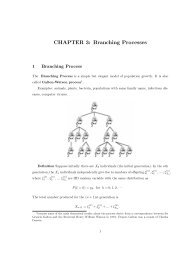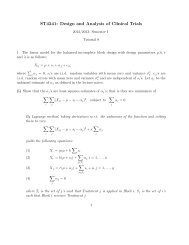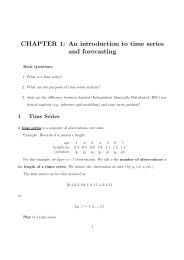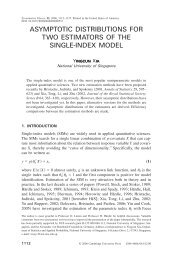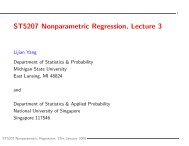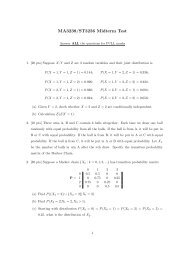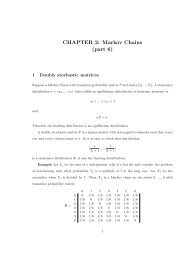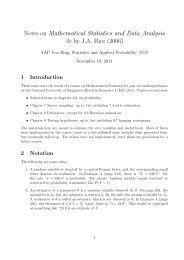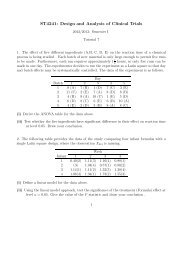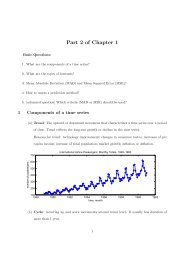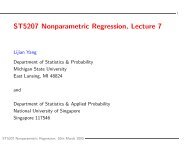Use Software R to do Survival Analysis and - The Department of ...
Use Software R to do Survival Analysis and - The Department of ...
Use Software R to do Survival Analysis and - The Department of ...
Create successful ePaper yourself
Turn your PDF publications into a flip-book with our unique Google optimized e-Paper software.
10 Accelarated Failure Time models<br />
In the exponential regression model, take the formulation with log transformation.<br />
log Y i = βZ i + ɛ i .<br />
If we <strong>do</strong> not assume the (st<strong>and</strong>ard) extreme-value distribution for the error term, <strong>and</strong> instead, let it be<br />
iid but arbitrary <strong>and</strong> unspecified, we get the (nonparametric) AFT model. This is similar <strong>to</strong> the usual<br />
linear model except the responses are censored <strong>and</strong> error distribution is arbitrary.<br />
Remark: <strong>The</strong> Cox model was a generalization <strong>of</strong> exponential regression model in the hazard formulation,<br />
without using the log transform.<br />
We want <strong>to</strong> estimation the parameter β with censored observations <strong>of</strong> T i : T i = min(Y i , C i ), δ i =<br />
I [Yi≤C i].<br />
In both estimation method below, we need the definition <strong>of</strong> residuals:<br />
e i (b) = log T i − bZ i<br />
Notice the order <strong>of</strong> the residuals depend on the b.<br />
10.1 Buckley-James estima<strong>to</strong>r<br />
<strong>The</strong> Buckley-James estima<strong>to</strong>r <strong>of</strong> the parameter β can thought <strong>of</strong> as the nonparametric version <strong>of</strong> the<br />
EM algorithm: where the censored residual is replaced by expected values (E-step). <strong>The</strong>n followed by<br />
the usual regression M-estimation procedure.<br />
<strong>The</strong> non-parametric nature <strong>of</strong> this procedure appears in both the E-step (where you <strong>do</strong> not have<br />
a parametric distribution for the residuals); <strong>and</strong> M-step (where you <strong>do</strong> not miximize a parametric<br />
likelihood, but use least squares etc.).<br />
<strong>The</strong> calculation <strong>of</strong> least squares Buckley-James estima<strong>to</strong>r can be found in the R function bj(), inside<br />
the Design library. <strong>The</strong> trustworthyness <strong>of</strong> the variance estimation from bj() is in <strong>do</strong>ubt. Instead we<br />
recomm<strong>and</strong> use empirical likelihood. <strong>The</strong> calculation <strong>of</strong> quantile Buckley-James estima<strong>to</strong>r is available<br />
from the author.<br />
<strong>The</strong> statistical inference can be obtained via empirical likelihood. I wrote some R functions for this<br />
purpose. See bjtest() etc. inside the emplik package.<br />
10.2 Rank based estima<strong>to</strong>r for AFT models<br />
A nice summary <strong>of</strong> the rank based estimation can be found in Chapter 7 <strong>of</strong> Kalbfleisch & Prentice<br />
(2002); without the computing s<strong>of</strong>tware <strong>and</strong> the empirical likelihood (which we shall discuss in the<br />
following).<br />
<strong>The</strong> rank based estima<strong>to</strong>r ˆβ is the solution <strong>of</strong> the following estimating equation: (see Jin, Lin, Wei<br />
<strong>and</strong> Ying (2003))<br />
n∑<br />
0 = δ i φ(e i (b))[Z i − ¯Z(e i (b))]<br />
i=1<br />
where ¯Z(e i (b)) is the average <strong>of</strong> the covariates, Z j , that the corresponding e j (b) is still at risk at time<br />
e i (b), i.e. e j (b) ≥ e i (b). We assume the function φ(·) be either a constant (resulting a log-rank type<br />
14



